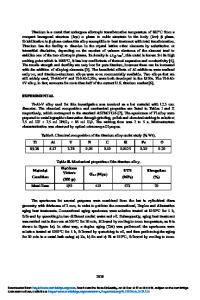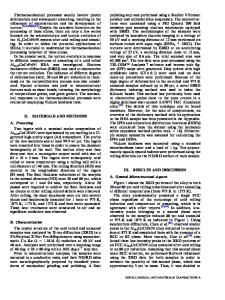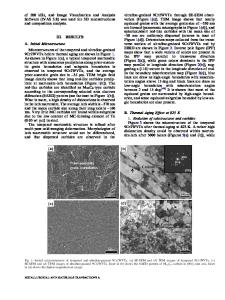Microstructure Evolution and Mechanical Properties of 2219 Al Alloy During Aging Treatment
- PDF / 1,807,232 Bytes
- 8 Pages / 593.972 x 792 pts Page_size
- 90 Downloads / 334 Views
JMEPEG DOI: 10.1007/s11665-017-2621-y
Microstructure Evolution and Mechanical Properties of 2219 Al Alloy During Aging Treatment Huimin Wang, Youping Yi, and Shiquan Huang (Submitted May 18, 2016; in revised form February 20, 2017) Hardness and tensile properties of 2219 Al alloys were tested at various temperature (150, 165, 175 °C) and subjected to T6 temper heat treatment to identify the peak aging time at various temperature. Microstructure evolution and precipitate behavior were analyzed with transmission electron microscope (TEM), differential scanning calorimetry (DSC) and x-ray diffraction (XRD). It is found that the peak aging time is 24 h at 150 °C and does not vary down to 165 °C. When the aging temperature rise to 175 °C, the peak aging time down to 12 h. Considering the strength and elongation, the optimum aging treatment is at 165 °C for 24 h after the solution treatment at 535 °C for 1.5 h. Compared with that of only waterquenched sample, after aged at 165 °C for 24 h, the tensile strength of the 2219 Al alloy increases from 324.5 to 411.8 MPa, yield strength from 168 to 310.8 MPa, respectively. The improvement in the mechanical performance is mainly attributed to the precipitation strengthening of the GP zones, h¢¢ and hÕ phases. Keywords
2219 aluminum alloy, aging behavior, mechanical properties, microstructure, precipitate
1. Introduction Aluminum and its alloys are desirable in many industries such as aircraft, automotive, appliances and food packaging due to their high strength-to-weight ratio and corrosion resistance. 2219 Al alloy (Al-Cu) is well known for its high specific strength, good corrosion resistance, reasonable creep strength and superior cryogenic properties (Ref 1-3). 2219 Al alloy is usually strengthened by precipitation hardening treatment. According to the previous work (Ref 4, 5), the precipitation behavior was established in an Al-Cu alloy as: supersaturated solid solution (ssss) fi quenched clusters fi GP Zones fi oherent h’’ (independent of GP Zones) fi semi-coherent h¢ fi stable h (Al2Cu). The coherency, size, inter-particle spacing and distribution of the precipitate dictate the strength of the alloy. In general, the precipitate should be coherent, fine and uniformly distributed in the matrix to obtain the best strengthening in the alloy. Some researchers have studied the mechanical properties and microstructural variation under different conditions (Ref 6, 7). Qu et al. discussed the influences of temperature and heat treatment status on the fracture toughness of 2219 Al alloy (Ref 6). Zhang et al. examined the effect of initial microstructure on the hot compression deformation behavior of 2219 Al alloy (Ref 7). The selection and application of 2219 Al alloy for structural components are severely constrained by insufficient tensile strength and ductility. In 2219 A1 alloy, strain hardening of Huimin Wang, Youping Yi, and Shiquan Huang, State Key Laboratory of High-Performance Complex Manufacturing, Central South University, Changsha 410083, China; and School of Mechanical and E
Data Loading...











